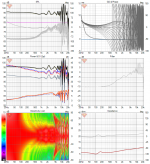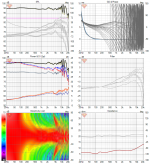Sadly no sound yet. I hope to be able to continue in about a months time.
You can follow my journey on this thread:
http://www.diyaudio.com/forums/full-range/242171-making-two-towers-25-driver-full-range-line-array.html
The overhaul that is planned will change the look of them (sadly enough). I hope they will still look beautiful afterwards .
.
You can follow my journey on this thread:
http://www.diyaudio.com/forums/full-range/242171-making-two-towers-25-driver-full-range-line-array.html
The overhaul that is planned will change the look of them (sadly enough). I hope they will still look beautiful afterwards
Anyone got any suggestions for a better way to wire these suckers?
Pre-tinned jumper wires from eBay: 500pcs Black 22AWG Double End Tinned 20cm Solder Jumper Wire Connector | eBay
2. Prevents series drivers from sharing the same enclosure volume (this is critical)
Why is this critical?
By the way, I'd like to listen to these speakers sometime - I'm in Ottawa too.
Pre-tinned jumper wires from eBay: 500pcs Black 22AWG Double End Tinned 20cm Solder Jumper Wire Connector | eBay
Damn. Where were these 2 years ago
Hi, there is a cure for the excessive lobing also called comb filtering of line arrays. At first, you must group the drivers symmetrically, for example the single center driver, its two neighbours, the surrounding 6, the surrounding 12 and the surrounding 24. Then you design a first-order crossover for the tweeter and its two surrounders; take-over frequency is in the vincinity of spatial Nyquist frequency, say has a lambda of twice the distance between neighbouring drivers. Then a crossover for the two surrounders and their surrounders, with half of the inner crossover frequency, as distances have doubled. And so on until you reach ends. Finally you look at over-all response, which prolly needs some gentle equalization. You end up with something as the one-way models of JBL's CBT series.
Reading this thread caused me a great deal of pain, knowing that I had just cheated when I built my line arrays.
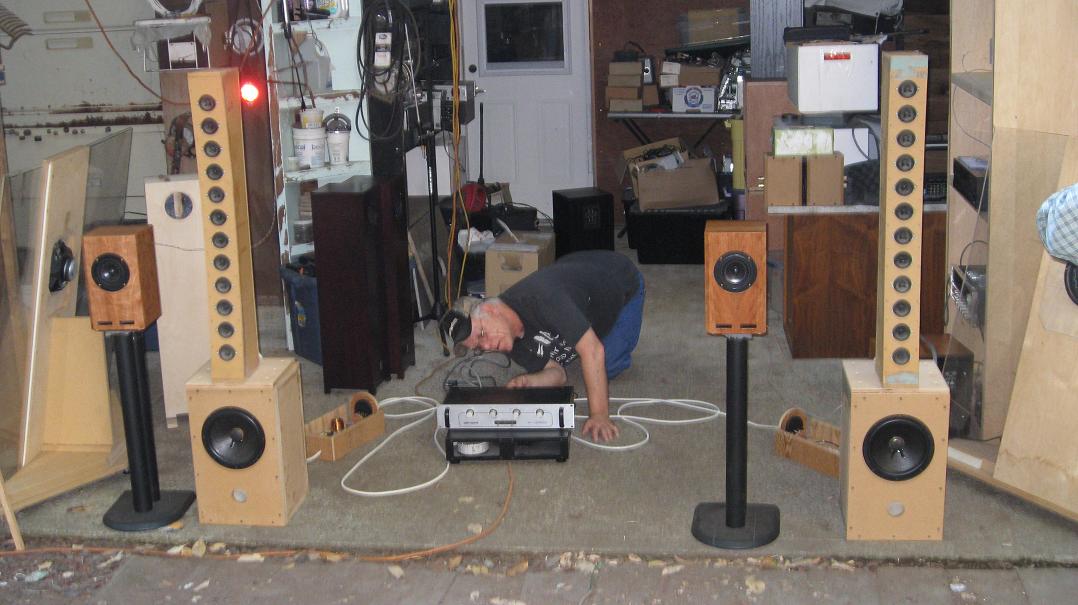
I simply avoided, like the coward that I am, all comb filtering, phase (timing) issues and other problems that I didn't want to deal with. That included tweeters, C2C issues and crossover difficulties were some of the difficulties that I avoided.
The array consists of twelve 1.5 inch (nominal) diameter drivers with some old Adire Audio AV 8 inch woofers crossed over (using a series crossover) at 450 Hz. The Bass unit is tuned to 33 Hz.
Voted "Best Midrange" at the RAW Fest (Canada), Kow Tow award at VSAC and 1st place in the 2-way class at "The Puget Sound! DIY Speaker Contest" (2010).
Total cost is right around $81.00.
Best Regards,
TerryO
Very nice !!! close to what i am building .
Any schematic of the crossover?
Reading this thread caused me a great deal of pain, knowing that I had just cheated when I built my line arrays.

I simply avoided, like the coward that I am, all comb filtering, phase (timing) issues and other problems that I didn't want to deal with. That included tweeters, C2C issues and crossover difficulties were some of the difficulties that I avoided.
TerryO
When you say you "avoided them", you simply ignored those concerns and went ahead with the build?
Did you ever measure for comb filtering?
How did you arrive at the curve for the baffle?
Is there a thread about your build?
Thank you,
David.
Hi, there is a cure for the excessive lobing also called comb filtering of line arrays. At first, you must group the drivers symmetrically, for example the single center driver, its two neighbours, the surrounding 6, the surrounding 12 and the surrounding 24. Then you design a first-order crossover for the tweeter and its two surrounders; take-over frequency is in the vincinity of spatial Nyquist frequency, say has a lambda of twice the distance between neighbouring drivers. Then a crossover for the two surrounders and their surrounders, with half of the inner crossover frequency, as distances have doubled. And so on until you reach ends. Finally you look at over-all response, which prolly needs some gentle equalization. You end up with something as the one-way models of JBL's CBT series.
And as a bonus, this approach can be used to 'curve' the array electronically instead of physically.
Passive Loudspeaker Delay
Hello Ownen. Did you happen to document this project?Hi Guys,
I just thought I would chime in here since I've built and have been living with a full range line array for the past year and a half.
I used 25 Vifa TC9FD18-08 3" drivers per channel, for a total of 50 drivers. The lines stand about 88" high, and the ceilings are about 125" high. The drivers are mounted frame to frame to get the closest possible C-C spacing which ends up being 3 5/16". The drivers are arranged in groups of 5 where each 5 driver group is wired in parallel and shares a common sealed section of the enclosure. Each group of five is then wired in series so you end up right back at the same impedance as a single driver. This arrangement is important because it does two things:
1. Prevents standing waves in an 88" high enclosure.
2. Prevents series drivers from sharing the same enclosure volume (this is critical)
I use a Behringer DEQ2496 before my DAC (entirely in the digital domain) to provide the necessary EQ for the lines. I'm sure you could tackle the EQ in the analog domain, but the DEQ is such a capable device that it's worth 10 times what it costs to buy, and the end result is better than you'd get with an analog filter. If you're building a line with full range drivers you absolutely will need active EQ of some sort.
I'm running the lines full range (without a sub) in a very large room, and I get genuinely flat response (-3dB) down to 20Hz. It's the absolute best bottom end you will ever hear from a loudspeaker. It has all the impact and depth of a really good subwoofer, with none of the horrible integration problems. It's literally seamless. My jaw dropped the first time I heard what they were capable of. They are also capable of playing at astonishingly loud levels, which translates into very good dynamics. If I were to relax the bottom end EQ so they rolled off at 40Hz, they would be more than capable in PA applications.
Of course, there's the elephant in the room which I'm sure half of you were repeating constantly in your heads as you read this: comb filtering.
Honestly, it's not that big of deal. As speaker dave mentioned a while back, if you're playing pink noise, and standing within a meter or so of the loudspeakers, you can definitely hear the lobing effect by moving your head up and down. It's also very easy to measure with a measurement mic. Once you're out around the 2 meter mark, it's barely noticeable, and any farther than that, you simply can't hear it anymore. Same applies with music, except you need to be about half the above distances to get the same effect. In other words, if you're playing music, and you're more than a meter from the array, it's not an issue.
The common argument is that point sources that radiate spherically into space will start to interfere with one another at frequencies with wavelengths that are equal to or shorter than the C-C spacing of the sources. This is indeed true, but since we're dealing with full range drivers, they're not perfect spherical radiators, especially at high frequencies. The narrowing dispersion at high frequencies helps to counteract this effect, and makes the drivers behave more like a line of ribbons at very high frequencies, which is exactly what you want. In practice, the arrays require very little EQ in the top end to counter this effect. For me, it's about a 6dB rise from 10kHz to 20kHz to make it sound and measure flat. My listening position is about 3.5 meters away from the front of the speakers.
Finally, I'd like to address the single biggest problem I have with the way people build these things:
DON'T USE CRUMMY DRIVERS!!!!!
This thread started off just like so many others:
"I found out that I can get a box of 50 terrible drivers for $25 and I think I'm going to build a line array out of them".
This is a HUGE mistake, and I can promise you that if you start with junk, you'll end up with junk (just more of it). All 50 of my drivers cost me $333 which is actually cheap compared to most loudspeaker projects. I picked them after carefully considering and auditioning 8 different 3" drivers. You really need to listen to the driver you plan on using as a full range driver with just one driver in a mocked up cabinet. If you don't like the way it sounds by itself, then using 50 of them isn't going to change that. I listened to each driver exactly the way it was, and then with EQ to make it flat. The Vifa drivers I chose were a little bright straight out of the box, but with some EQ they were by far the best sounding of the group.
The amount of work involved in actually building a pair is enormous, which is why you really need to put the effort and money into using a good driver to start with. Putting that much work into something only to ruin it by using 50 cent drivers is a genuine shame. Time and time again I see people putting hundreds of hours of their time into building a pair, and then skimping on the drivers to save a few hundred dollars. It's really sad, especially when there's so much potential!
I've attached a few pictures of the finished arrays, and hopefully someday I'll get around to properly documenting these in a proper project thread.
Cheers,
Owen
Did you ever see this:
The making of: The Two Towers (a 25 driver Full Range line array)
Or this:
Stupid Cheap Line Array
or this:
Drengur's build: Langanes 25 - Line arrays
This:
Peerless TC9 corner array build (low brow)
If you search the fullrange speaker thread for line arrays there are a LOT of projects described.
The making of: The Two Towers (a 25 driver Full Range line array)
Or this:
Stupid Cheap Line Array
or this:
Drengur's build: Langanes 25 - Line arrays
This:
Peerless TC9 corner array build (low brow)
If you search the fullrange speaker thread for line arrays there are a LOT of projects described.
can such a LA be built using 6.5" full range drivers? the full range drivers i have are whizzer cone based with Fs at 50hz and extend to 8-10Khz flat and then roll off gently. i know that at high frequencies, there will be serious combing issues and also center-to-center spacing is large, but if we are sitting 2 meters away from the column, how much of it would be affecting us badly? i am thinking of 14-15 6.5" full range drivers in a corner LA which would span from floor to ceiling of about 8ft at least.
It would , but IMHO the compromises using so big drivers are too many compared to the Vifa TC9. If you place a LA with 25 TC 9 in a corner in a reasonably sized room, you will have no problems in the Bass. Just don't make the same mistake as I did: making the enclousure too small.. My choise of an Alu profile as encclousure resulted in a too small rear chamber for the drivers and as I play them in a big (> 60 sqm) I have a little issue in the bass department, so I have made a subwoofer to aid the main arrays in the button.
i have some doubts with LA functioning,
1. what is the max center-to-center spacing allowed for bigger drivers before it becomes noticeable at 2 meters listening distance?
2. in which frequency band, LA proves to be advantageous. for example many reviews talk about wide sound stage, pin point imaging, cleaner bass and room interaction etc. old McIntosh xrt models had bass and mids in normal boxes, while tweeters were in LA. so upto what max frequency point, i should consider LA to produce? for example if 3KHz then, i will xover the driver at 3Khz to a single high efficiency tweeter. this way i can still enjoy all benefits of LA while using bigger drivers.
1. what is the max center-to-center spacing allowed for bigger drivers before it becomes noticeable at 2 meters listening distance?
2. in which frequency band, LA proves to be advantageous. for example many reviews talk about wide sound stage, pin point imaging, cleaner bass and room interaction etc. old McIntosh xrt models had bass and mids in normal boxes, while tweeters were in LA. so upto what max frequency point, i should consider LA to produce? for example if 3KHz then, i will xover the driver at 3Khz to a single high efficiency tweeter. this way i can still enjoy all benefits of LA while using bigger drivers.
One of the main features of line arrys with something like the Vifa TC9 is fullrange coverage without crossover. Wide and uniform disperssion in the horizontal plane , no reflections from (well almost) cieling and floor.
Roger Russel , former McIntosh made the IDS25 that has inspired all of the LA with Vifa TC9 ....Look that up. And read some of the links Wesayso and I have pointed you to.
Wesayso's "the making of the two towers------" has all the information you need, but , admitteldly, very long...Happy reading

Roger Russel , former McIntosh made the IDS25 that has inspired all of the LA with Vifa TC9 ....Look that up. And read some of the links Wesayso and I have pointed you to.
Wesayso's "the making of the two towers------" has all the information you need, but , admitteldly, very long...Happy reading

yeah koldby. I have gone thro IDS25 literature. have read through few pages in Wesayso's thread. good deal of info is there. but very long thread. someday i will finish it!
for now i need to make decision between driver size. tc9 drivers are not available locally. the 3" FR i have locally dont have specs comparable to tc9 like large xmax or Fs. tonal quality of them is questionable compared to tc9. but have access to bigger drivers which are of good quality. Hence trying to first decide if at all its possible to use bigger drivers and still retain the benefits of LA.
for now i need to make decision between driver size. tc9 drivers are not available locally. the 3" FR i have locally dont have specs comparable to tc9 like large xmax or Fs. tonal quality of them is questionable compared to tc9. but have access to bigger drivers which are of good quality. Hence trying to first decide if at all its possible to use bigger drivers and still retain the benefits of LA.
One of the reasons Mr. Roger Russell (RIP) mentioned for using tweeter arrays was power handling. He stated that the tweeters often were the weakest link and would run out of steam first.
I wouldn't make an array with drivers larger than 3.5" and expect them to work well even at 2 meters. A single tweeter is not a great solution for such a setup. It isn't easy to integrate the tweeter into an array as it would cause a coverage pattern mismatch as well as differing attenuation with increasing distance. The arrayed drivers will fall off at 3dB/doubling distance while the tweeter falls off at 6dB/doubling distance.
Should you be interested in the TC9, Digi-key has them back in stock, the price is up a bit though, but still not bad. Other companies should follow soon.
An array of TC9's has the most output around 250 Hz, at 2 meter it would show combing starting from ~8500 Hz and up. At larger distances this frequency will move up higher.
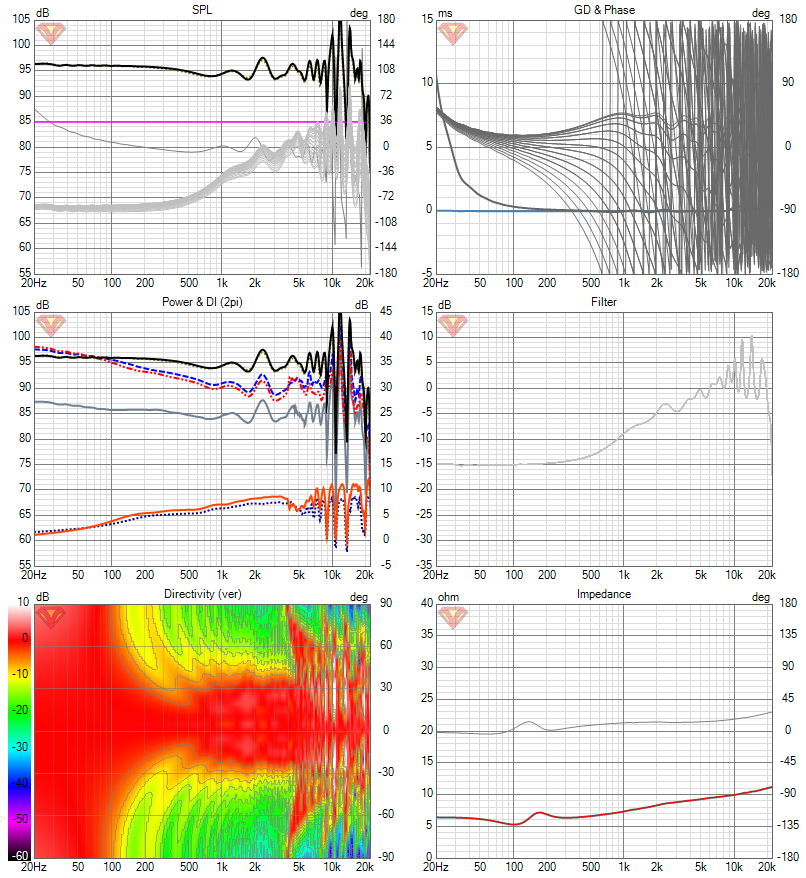
Note: the above sim was made for a listening distance of 2.7 meter. I just adjusted it to 2.0 meter to watch the effects.
One could make a frequency dependent shaded array to get rid of most combing problems, or at least move them up even further. I have added these type of filters to my array and I published the sims and schematics on my thread.
Here's how that filtered array looks at 2.0 meter:
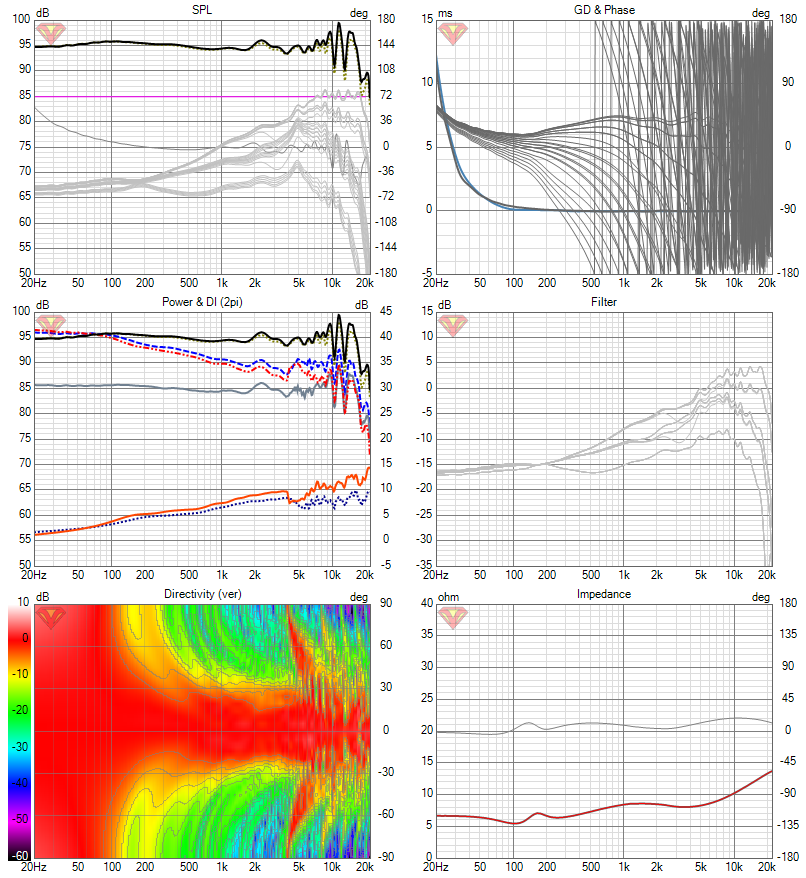
Easy to see it has better vertical pattern control and combing moves up to 10.000 Hz+. Again, this sim was originally created for a listening distance of 2.7 m.
I wouldn't make an array with drivers larger than 3.5" and expect them to work well even at 2 meters. A single tweeter is not a great solution for such a setup. It isn't easy to integrate the tweeter into an array as it would cause a coverage pattern mismatch as well as differing attenuation with increasing distance. The arrayed drivers will fall off at 3dB/doubling distance while the tweeter falls off at 6dB/doubling distance.
Should you be interested in the TC9, Digi-key has them back in stock, the price is up a bit though, but still not bad. Other companies should follow soon.
An array of TC9's has the most output around 250 Hz, at 2 meter it would show combing starting from ~8500 Hz and up. At larger distances this frequency will move up higher.
Note: the above sim was made for a listening distance of 2.7 meter. I just adjusted it to 2.0 meter to watch the effects.
One could make a frequency dependent shaded array to get rid of most combing problems, or at least move them up even further. I have added these type of filters to my array and I published the sims and schematics on my thread.
Here's how that filtered array looks at 2.0 meter:
Easy to see it has better vertical pattern control and combing moves up to 10.000 Hz+. Again, this sim was originally created for a listening distance of 2.7 m.
Attachments
I favor a good 2.5 to 3.5 inch diameter driver for your new array. While not a straight array nor cheap, my Modified CBT 24's use the superb SB65WBA. The CBT 24s were designed to be two-ways with subs as well. I count on subs to cover below 125 Hz. CBTs also do not have comb lines vs straight lines.
Ronald's use (EQ and such) of the TC9 come close to a one way line array for a small driver.
My Needles had 3.5 inch Tangband drivers but very good highs because of the ribbon tweeter. They still needed subs which meant it was a three way speaker.
Ronald's use (EQ and such) of the TC9 come close to a one way line array for a small driver.
My Needles had 3.5 inch Tangband drivers but very good highs because of the ribbon tweeter. They still needed subs which meant it was a three way speaker.
Last edited:
- Home
- Loudspeakers
- Multi-Way
- Stupid Cheap Line Array
